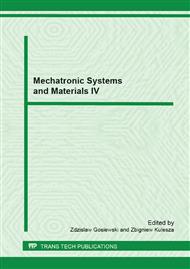[1]
F. Giulietti, L. Pollini, M. Innocenti, Autonomous Formation Flight, IEEE Control System Magazine, Vol. 20, No. 6, pp.34-44, (2000).
Google Scholar
[2]
S. Wan, G. Campa, M. R. Napolitano, B. Seanor, Y. GU, Design of Formation Control Laws for Research Aircraft Models, AIAA Guidance, Navigation and Control Conference and Exhibit, 11-14 August, Austin, USA, AIAA article number 2003-5730, (2003).
DOI: 10.2514/6.2003-5730
Google Scholar
[3]
D. P. Scharaf, F. Y. Hadaeg, S. R. Ploen, A Survey of Spacecraft Formation Flying Guidance and Control (Part II): Control, Proceedings of the 2004 American Control Conference, Boston, (2004).
DOI: 10.23919/acc.2004.1384365
Google Scholar
[4]
J. L. Dargan, M. Pachter, J. J D'Azzo, Automatic formation flight control, Proc. AIAA Guidance, Navigation and Control Conference, pp.838-857, (1992).
DOI: 10.2514/6.1992-4473
Google Scholar
[5]
L. E. Buzoganny, M. Pachter, J. J. D'Azzo, Automated control of aircraft in formation flight, Proc. AIAA Guidance, Navigation and Control Conference, pp.1349-1370, (1993).
DOI: 10.2514/6.1993-3852
Google Scholar
[6]
M. Veth, M. Pachter, J. J. D'Azzo, Energy preserving formation flight control, AIAA Aerospace Sciences Meeting and Exhibit, (1995).
DOI: 10.2514/6.1995-335
Google Scholar
[7]
V. P. Reyna, M. Pachter, J. J. D'Azzo, Formation Flight Control Automation, Proc. AIAA Guidance, Navigation and Control Conference, pp.1379-1404, (1994).
DOI: 10.2514/6.1994-3557
Google Scholar
[8]
S. McCammish, M. Pachter, J. J. D'Azzo, V. Reyna, Optimal Formation Flight Control, AIAA Guidance, Navigation and Control Conference, p.3868–3880, (1996).
Google Scholar
[9]
J. D. Boskovic, Z. Sun, Y. D. Song, An adaptive reconfigurable formation flight control design, Proc. American Control Conference, 2003, pp.284-289.
Google Scholar
[10]
Y. Li, B. Li, Z. Sun, Y. D. Song, Fuzzy technique based close formation flight control design, Industrial Electronics Society, IECON Conference of IEEE, (2005).
DOI: 10.1109/iecon.2005.1568875
Google Scholar
[11]
B. Li, X. H. Liao, Z. Sun, Y. Li, Y. D. Song, Robust Autopilot for Close Formation Flight of Multi-UAVs, System Theory, Proc. Of the Thirty Eight Southeastern Symposium, pp.258-262, (2006).
DOI: 10.1109/ssst.2006.1619084
Google Scholar
[12]
C. J. Schumacher, S. N. Singh, Nonlinear Control of Multiple UAVs in Close-Coupled Formation Flight, AIAA paper 2000-4373, (2000).
DOI: 10.2514/6.2000-4373
Google Scholar
[13]
R. D. Gingras, Experimental Investigation of a Multi-Aircraft Formation, AIAA paper 99 3143, (1999).
Google Scholar
[14]
C. E. Hanson, J. Rayan, M. J. Allen, S. R. Jacobson, An overview of Flight Tests Results for a Formation Flight Autopilot, AIAA paper 2002-4755, (2002).
DOI: 10.2514/6.2002-4755
Google Scholar
[15]
G. Campa, B. Seanor, Y. Gu, M. R. Napolitano, NLDI Guidance Control Laws for Close Formation Flight, American Control Conference, (2005).
DOI: 10.1109/acc.2005.1470426
Google Scholar
[16]
Z. Gosiewski, L. Ambroziak, Formation Flight Control Scheme for Unmanned Aerial Vehicles, LNCIS series, Springer Verlag, No. 422, pp.331-340, (2012).
DOI: 10.1007/978-1-4471-2343-9_28
Google Scholar
[17]
K. Sibilski, Modelowanie I symulacja dynamiki ruchu obiektów latających, Oficyna wydawnicza MH, Warszawa, (2004).
Google Scholar
[18]
J. Roskam, Airplane Flight Dynamics and Automatic Flight Controls, DAR Corporation, (1995).
Google Scholar


